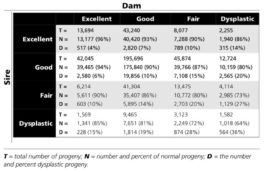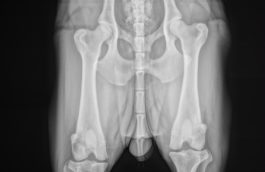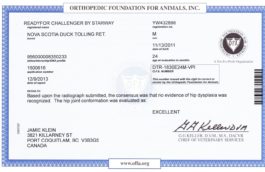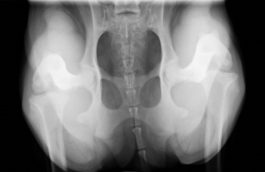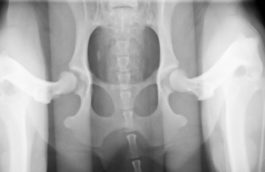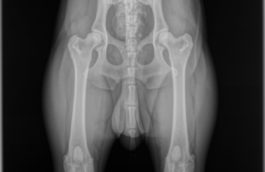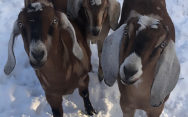Canine Hip Dysplasia
Description
In some breeds of dogs, Canine Hip Dysplasia (CHD) is the most common cause of osteoarthritis or degenerative joint disease. It is currently accepted to be an inherited disease caused by the interaction of many genes. No environmental cause has been found, but environmental factors may influence the degree of expression of the genes within an individual. Currently, the only means for reducing the genetic frequency of CHD is to be selectively breeding for normal hips.
Many dysplastic dogs demonstrate some observable sign between 3 and 15 months of age, while in a smaller number of dogs the sign are not observable until old age (chronic or arthritic phase). CHD may occur in only one hip. The clinical signs of CHD vary from decreased exercise tolerance to severe crippling. They include: reluctance or inability to go up or down stairs, difficulty in rising from a sitting or prone position, bunny-hopping gait when running, stiffness early in the morning that improves as the dog warms up, change in disposition due to pain, lameness after exercise, wobbly gait, a clicking sound when walking, to name a few.
CHD occurs in all breeds, regardless of size, and frequency of CHD is breed dependant. The vast majority of breeders are honest. However, a small number of breeders choose to be dishonest and misrepresent the hip status of their dogs. Dogs with CHD should not be bred. Only selectively breeding known clear dogs will control the frequency of CHD.
CHD cannot be diagnosed by observing how the dog moves, acts, lies down, etc. The clinical signs may be caused by other problems. Therefore a complete orthopedic and radiographic examination is required before arriving at the conclusion that the symptoms are caused by hip dysplasia.
Diagnosis
ORTHOPEDIC FOUNDATION FOR ANIMALS:
For dogs 24 months of age or older that are potential breeding prospects, submission of a specific view of the pelvis to the Orthopedic Foundation for Animals will allow evaluation by multiple board certified radiologists and issuance a grade of the status of the dogs hips. It is recommended that screening of females is best scheduled during anestrus. This form must accompany all images submitted to the OFA. These radiographs are done at your veterinary office by appointment and the dog’s certificate of registration or a copy of this information as well as a completed and signed OFA application form should be available at the time of radiography. Since it is vital that a properly positioned radiograph be obtained, the dog will require a short acting anesthetic.
Only those dogs with Excellent, Good, or Fair hip joint conformation will receive an OFA Certificate with the official grading, a breed number, and could be used in a breeding program.
Those with Borderline, Mild, Moderate, and Severe Hip Dysplasia will not receive an OFA breed number and should not be bred.
Results are included on a public data base allowing stats to be monitored for specific breeds as well as breeders to be able to research pedigrees to aid them in making appropriate breeding decisions. The owners of the dogs can opt out of including their results in the public data base, but it is not recommended.
PennHIP:
Radiographs can also be submitted to PennHIP for evaluation. Information about this process and the requirements can be found on the website.
Three views of the pelvis are taken on the anesthetized dog. To obtain diagnostic quality radiographs, the muscles must be completely relaxed. For the comfort and safety of the dog, this requires either a heavy sedation or general anesthesia.
The three views are required are a Distraction View, a Compression View, and a standard Extended Ventral Dorsal View.
The quantitative measurements of the hip joint laxity or distraction index are obtained from the Distraction View, hip joint congruity reading are from the Compression View, and osteoarthritis readings are taken from the standard Extended VD view.
These views can be obtained as early as 16 weeks of age with accuracy of the readings improving as the dog matures to 3 years of age. For all dogs, PennHIP recommends using the average of repeated evaluations to get a more reliable estimate of the dog’s hip laxity status.


